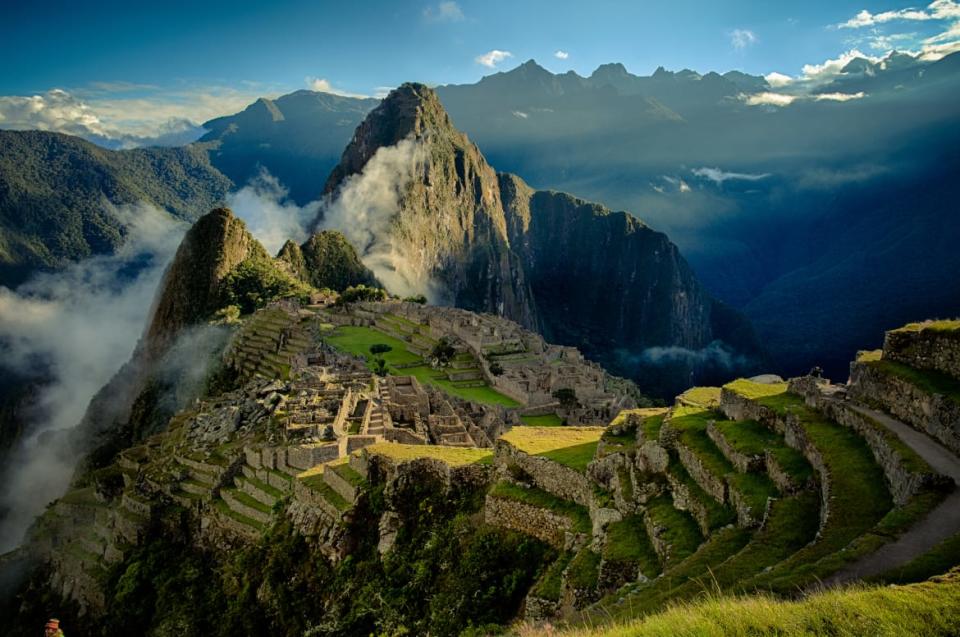Peru’s Most Popular Attraction Isn’t Always Its Best

It was after dark by the time our train finally pulled into the station at Ollantaytambo, a charming, picturesque town nestled in Peru’s vibrant Sacred Valley, and I couldn’t wait for a hot shower, a hot meal, and a cold beer at Las Qolqas where I was staying.
Even from Ollantaytambo, endearingly shortened to Ollantay by locals, the journey to Machu Picchu, considered the crown of the Sacred Valley and Peru’s number one tourist attraction, is long. Requiring a luxury 90-minute or no-frills two-hour train ride (reservations must be made in advance), followed by a winding, dizzying bus ride up to the top of Machu Picchu, where entry not exceeding three hours is granted based on your ticket time window, it’s a heck of a day trip.
This was my second time in Peru, my second time visiting the country’s claim to fame. I first visited in August 2009, and while I can definitively say the journey to the famous site, physically arduous and mentally challenging via the Lares Trek, an alternative to the popular Inca Trail, was incredibly rewarding and memorable, I’ve always felt guilty admitting that I found Machu Picchu itself underwhelming. It was Torres del Paine in Patagonia, the Salar de Uyuni in Bolivia, and the Galapagos Islands in Ecuador which topped my backpacking year’s highlights, but I wanted to be gobsmacked by Machu Picchu too.
“I took two women here recently, and they started crying, they were so moved,” my veteran guide, Porfirio Carbajal Gutierrez, told me, perhaps sensing my inadequate appreciation this time around as we followed the designated path, gingerly avoiding others’ ubiquitous selfie moments.
The bucket list attraction failed to inspire me yet again.

The cold, steady drizzle I hadn’t planned for and the steady stream of people I had, didn’t help. And although Gutierrez’s comment stung for a second, what I was left with after we’d journeyed back down to the tourist town at the base, where I had roughly four hours to reflect on the experience before boarding the train back, was the stunning realization that my initial impression hadn’t been wrong, immature, or lacking. It had simply been honest.
The truth was, I valued my conversation with Gutierrez over lunch at the excellent Italian restaurant with a Peruvian influence more than listening to his knowledgeable teachings on the Royal Tomb Palace and Temple of the Condor, some of Machu Picchu’s most revered marks. It meant more to me to swap stories about our experiences in the early days of the pandemic than to digest tidbits about the lauded ruins on a roped path en route to the exit.
As for ruins, the Pumamarca ruins Gutierrez and I had explored the day before were more my speed. Accessed just off the Las Qolqas property, the 13.4 km moderate trek, rope-free and free of charge too, is one of the Sacred Valley activities Carlos Gonzalez, co-owner of Las Qolqas, recommends. Set on a steep hillside, the ruins, considered one of the first settlements of the Incas, are now comprised of leftover pieces of storage houses and ceremonial structures, overlooking the sprawling valley below. From the highest point, about 11,142 feet, you can take in panoramic views of village homes, farmland, and two rivers: Río Patacancha and Yuracmayo.
The roaming llamas (babies too!), deeply aromatic mint growing like weeds, a lone cow or two basking in the sun and munching on sweet, green grass, and absence of a robotic crowd, add to the trek’s appeal. You’re unlikely to cross paths with many other tourists along the way, though rest assured, at one point you may welcome the site of a straw hut selling Inca Cola, that sweet, yellow drink reminiscent of Mountain Dew, and the local beer, Cusquehana. This is also where you might find Indigenous women selling various handmade trinkets—llama keychains, colorful scarves, finely woven change purses—for a few soles.
Gonzalez and his team at Las Qolqas, a unique property amid the town’s rustic hospedajes and inns, encourage off-site exploration even as the ecolodge beckons guests to bask in the beauty and calming nature of the resort’s facilities. Gonzalez prides himself on hiring—and training—staff who don’t have the traditional background and experience many hiring managers in the hospitality industry require. They have made it easy to explore Pumamarca and other ruins and trails surrounding the lodging’s lush grounds by enlisting the help of Fat Map, an outdoor adventure platform with geolocation capabilities. The hospitality-minded Gonzalez says, “As long as you have a mobile data signal in your phone, you can easily navigate those maps and go out and enjoy the experience on your own.”
When I was on the backpacking circuit years ago, I was content, if unimpressed, with my stays at inexpensive inns and hostels, where all I really needed was a bed and decent night’s sleep before the next day’s adventure, but at Las Qolqas, I had the opportunity to really relish that night’s sleep, thanks to a quietly roaring wood-burning fireplace prepared by a staff member each night, and a large, cozy bed that took up most of the space in the African safari-like raised tent.
The sparse room meant going to the main building each morning to procure coffee as there is no coffee maker in the room, before retreating back to my tent and settling into a porch chair with a book or my journal. Although I’ve never participated in a traditional writer’s retreat, the likes of which seem particularly well suited in places like Vermont, Upstate New York, and other rural places around the U.S., I can imagine Las Qolqas’s inspiring writers and stoking creativity. But it also works well, as I discovered, as a place to practice mindfulness and gratitude, to consider Peru’s history and its people.
Communal dining tables encourage guest mingling, though during my stay, Las Qolqas wasn’t at capacity and so those traveling together—couples and families—tended to have an entire table all to the themselves for which to enjoy meals incorporating produce grown on site and fish (trucha or trout) caught in the nearby river.
Like both the Pumamarca ruins and the town’s eponymous ruins, both of which can be easily accessed without any fuss or advance reservations, Machu Picchu can be explored without the help of a guide. But Gonzalez, who has been visiting the 15th-century Inca City since he was a little boy, believes most visitors will benefit from going with a guide. Even so, Gonzalez told me most guests of Las Qolqas admit Machu Picchu isn’t the best part of their visit to Peru. “Once a traveler finishes with their trip… they are surprised to realize that there were other aspects of their trip, especially the local culture, interacting with the local people, the food, and certain immersive experiences with the local culture which become the highlight of their trip,” Gonzalez shared.
Immersing myself in the local culture began on my first day at Las Qolqas, when I asked Virginia Ontón, the gracious house manager, if we could speak only Spanish for the duration of my stay. The staff obliged, and although I struggled at first to remember certain words and correct verb tenses, by the time of my Pisco Sour and Pisco Punch-making class led by Carlos and Miguel, my Spanish had improved. I knew it would never come close to 13 years ago when immersive couch-surfing stays across South America got me to the point where I not only dreamt in Spanish but effectively regaled native Spanish speakers with my recollection of them, but at least it was a start.
From Las Qolqas, there’s a shortcut to the center of town, and from there, more ruins, via the Pinkuylluna Storehouse hike, which affords incredible views of Ollantaytambo. Like Aquas Calientes, the tourist town at the base of Machu Picchu, Ollantay can also feel a bit heavy of the catering-to-tourists bit, especially around the center plaza where signs for pizza and hamburgers attempt to lure hungry backpackers, but from the top of the trail, it’s all adobe houses, cobblestone streets, and bright green farmland. The benches dotting the main plaza serve as a fine people-watching perch post hike—and a place to pick up a llama keychain or handmade change purse. While it’s entirely possible the souvenir trinkets in Ollantaytambo are indistinguishable from those being hawked in Aquas Calientes, the vibe in this part of the Sacred Valley is distinct. The history in the cobblestoned streets and adobe homes and inside the Mercado San Pedro, feels quietly preserved as opposed to loudly advertised.
There isn’t a ton to do in Ollantaytambo, less so at Las Qolqas itself (though I also recommend the ceviche-making class, followed by ceviche-eating, of course, and a visit to the spa’s outdoor thermal bath), but this quiet, these relaxed vibes—particularly welcome after a visit to Machu Picchu—encourage a slower way of travel, a less harried existence. A being in the moment, if you will. After dark at Las Qolqas, the estrellas (stars) provide a rare opportunity to do nothing but take it all in from your own private porch. Paired with a glass of Peruvian Malbec, it’s magical.
Get the Daily Beast's biggest scoops and scandals delivered right to your inbox. Sign up now.
Stay informed and gain unlimited access to the Daily Beast's unmatched reporting. Subscribe now.

 money
money 